
An award-winning Minnesota hog
operation finds the most effective manure management approach includes
a strong focus on records and taking care of the details.
An award-winning Minnesota hog operation finds the most effective manure management approach includes a strong focus on records and taking care of the details.
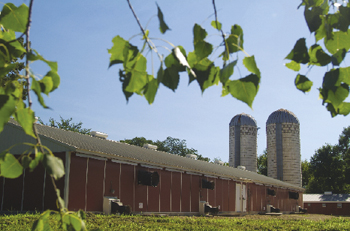 The Braun Farms’ efforts in manure management, and their high standards in general farm management, were recently recognized by the Pork Checkoff of the National Pork Board. The Brauns were one of four pork production operations to receive the 2006 Pork Industry Environmental Steward Awards. The Braun Farms’ efforts in manure management, and their high standards in general farm management, were recently recognized by the Pork Checkoff of the National Pork Board. The Brauns were one of four pork production operations to receive the 2006 Pork Industry Environmental Steward Awards. |
When it comes to describing one of the main features of a successful manure management plan, Bob Braun’s comments are similar to the old saying about the three most important things about real estate being “location, location and location”.
“One of the key things in manure management is records, records and records,” says Bob, one of three brothers—the others being David and Brian—who own and operate the Braun Farms hog operation near Le Sueur, Minnesota. The brothers have a 1,400 head nursery, two 1,400 head finishing barns, and 2,500 acre row crop operation.
Bob says they try to take a systems approach to manure management itself, and to how manure management fits within the bigger picture of managing the farm. “It helps to take a look at the whole puzzle, if I can put it that way, and making sure all the pieces fit together, including keeping records.”
David Braun added that it’s important to work on the details in managing manure because, as with many things, the devil can truly be in the details. “It’s kind of a culture or attitude—you need to have a mindset that you’re not going to get caught up and simply do the most expedient or time efficient thing at times. You need to do it right, and do it according to your plan.”
The Braun Farms’ efforts in manure management, and their high standards in general farm management, were recently recognized by the Pork Checkoff of the National Pork Board. The Brauns were one of four pork production operations to receive the 2006 Pork Industry Environmental Steward Awards. The awards are given to operations that have demonstrated a commitment to protecting the environment while conducting their day-to-day activities—which describes Braun Farms to a “T”.
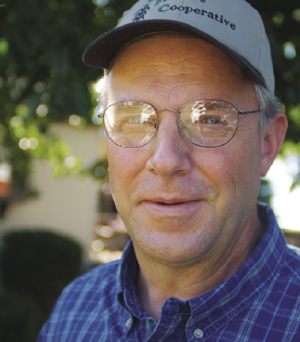 David Braun |
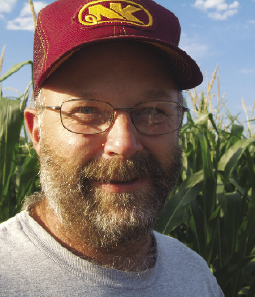 Bob Braun Bob Braun |
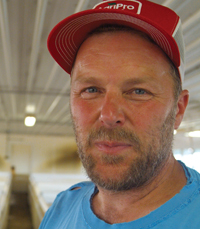 Brian Braun |
The three brothers all work diligently—and hard—to run general farm operations, but each has specific responsibilities. David manages the nursery, and is also involved with manure application, being a state-licensed certified waste applicator. Bob is responsible for the crops side, and does the manure management planning, establishing rates of application. It’s a natural fit considering he’s setting the yield goals for their crops. Brian oversees the day-to-day operation of the finishing site.
“That said, we work as a team,” notes David. “We all move around, shift jobs, and work where the work is, rather than just sticking strictly to this area or that area of the farm.”
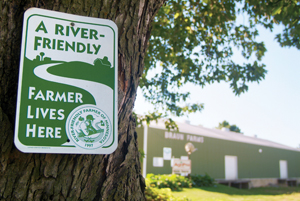 There has been a strong tradition of land stewardship in the Braun Family. Paul Braun, father of Bob, David, and Brian, was one of the first farmers in the area to start minimal tillage in the 1970s. There has been a strong tradition of land stewardship in the Braun Family. Paul Braun, father of Bob, David, and Brian, was one of the first farmers in the area to start minimal tillage in the 1970s.
Farms need to get the environmental message out The environmental and stewardship bar has been set high for U.S. farms, and livestock operations are generally doing a good job at meeting those standards, David Braun says. Still, the industry needs to do a better job of getting out the message that it is pro-active in terms of the environment and animal care, he added. That said, the Brauns feel fortunate in that the industry seems to be heard at the Minnesota Statehouse in St. Paul. “I’d have to say that our state government is very aware of what ag does for the economy. While they want to make sure we have environmentally sound practices, they are also very cognizant of the economics of the business. Some measures have been phased in over several years to allow farmers to adapt, and not put undue financial stress on them.” If anything, it’s what’s going on in Washington, D.C., that concerns them. “It’s ironic when you think about it,” says David. “Here you have people who want to call manure toxic waste, but yet there is a huge campaign out there for sustainable agriculture.” |
While the farm is a large operation now, at 2,500 acres, the “home farm” making up a small part of that dates back over 100 years in the Braun family. And there’s been a strong tradition of land stewardship during that time.
Bob notes that their father, Paul, was one of the first farmers in the area to start minimal tillage in the 1970s.
“We’ve followed through on that,” he says. “We have trouble warming up some of the soil types enough for no-till because we’re fairly far north, but where the ground allows us, we’re doing no tilling. The farm was designed with environmental considerations in mind, as were their operations, he added. “With our manure handling, and the underground pits in the barns, that was all done with both minimizing odors and preventing leaks in mind.”
The hog facilities are built atop eight-foot deep reinforced concrete pits—that are engineer designed—which have a capacity of one year’s manure. The floor of the pit is concrete slab, with the hogs on a concrete slat floor. They have tube feeders, with a four or five foot tube set over a stainless steel shelf. On either side of the shelf is a well with a nipple.
“With this set-up, the pigs can either eat dry feed off the shelf, working the tube and nudging it out, or they can shove the feed into the well and mix it with water and eat it damp,” explains David.
“If it’s kept properly adjusted, it minimizes waste and minimizes the amount of water that gets wasted—the pigs can’t play with it and cause an excess of water to collect in the manure pit.”
The pits are usually pumped out in the spring and fall. The farm has a significant land base, so they stretch the manure application program out to a four-year rotation on their crop lands.
And what goes into the hogs has a direct influence on exactly what is going to be spread on those crop lands. “How we feed the hogs and what we feed them has an effect on the volume and type of nutrients in the manure,” says David. “Overall, we try to minimize the manure volume, but when it comes to using it on the cropland, we try to maximize the acreage covered and maximize the nutrients.”
For most of the last 10 years, they’ve been working with feed rations that include phytase. The result is the animals more completely digest or absorb phosphorus from the rations, meaning less phosphorus in the manure. “It seems to work out as both an environmental plus and an economic plus for us,” says David.
Careful thought went into the site of the two finishing barns when they were built a decade ago. They are in the middle of an area where there is lots of land that can benefit from the nutrients. This location also, of course, minimizes how far manure has to be hauled.
While factoring in nutrient and manure management is pretty much second nature to Braun Farms now, both David and Bob said it has been a learning experience along the way.
“One of the ongoing things for us is continuing to learn how to best comply with the ever-changing rules and regulations,” says Bob. “It’s become highly regulated and you have to stay well versed of what is going on, and be diligent about the details.”
To stay ahead of the regulatory curve, Braun Farms was one of the first in the area to do grid soil sampling and yield mapping, and they also apply anhydrous ammonia at a variable rate. And this, along with manure application and their very trusty AgLeader system on the tractor, produces those very valuable records Bob talks about as being central to their manure management approach.
“There’s hardly a trip across the field that we don’t use the AgLeader monitor to document what we are doing,” he says.
The AgLeader is used to map out the areas where they apply manure. “We don’t have a flow meter on the tank—we know how much it holds and how many acres we can cover, so the math is pretty easy to determine what our rates are,” says Bob.
“But I think the day is coming when we’ll be looking at going for a flow meter, and to apply the manure at a variable rate.” He added that they are grappling with the changing make-up of the manure itself, in terms of its nutrient components, so they can make variable rate application work in the most effective way.
“We need to figure out what is driving the application—is it the phosphorus, the nitrogen or potassium?” added David. They’ve been working to think this through and the time for a flow meter will be further down the road, when they reach some conclusions.
In the meantime, the Brauns feel they are getting the most of out of the nutrients in the manure. Using a 6,000 gallon Houle tanker, they use double-disc injectors to fully incorporate the manure effluent into the soil. “With the twin discs, a swatch of top soil is folded over a swath of manure, about a foot wide, that is laid down,” explains Bob. The discs are spring loaded so they roll a ridge of soil between them.
“That immediate covering minimizes odor in the application process, and does a good job of preserving the nutrients in the soil for the following crop.”
But he noted that it also leaves the field ridged, requiring a tillage pass before planting a crop—not the most desirable thing when the goal is no-till.
“We’re actively looking for some kind of implement that will spread and inject over enough subsurface area so the manure is available for a crop, but will leave the surface level and the previous crop residue largely undisturbed.”
To get maximum use of the Houle tanker, they also haul for a neighboring farm, a 3,000 head hog operation. With this and their own operation, they will haul upwards of two million gallons of manure a year. They also have a Houle pump/agitator.
They haul in both the spring and the fall. For general good housekeeping reasons and to guard against not being able to haul due to bad weather, they always work on hauling from the bottom half of the pits. “It makes for a better atmosphere in the barns,” David notes.
Every time they haul, samples are sent in for analyzing N, P, K, dry matter and from time to time, for micro-nutrients.
Using the sampling information, along with past cropping history, rates are determined for each field. “We’ve got that well figured out before we’ve even got the first load of manure in the tank,” says Bob.
They work off previous year manure tests, rather than current season tests. For example, for the hauling they will be doing in Spring 2007, they will refer back to tests from previous Spring seasons.
”They do vary,” notes Bob. “We talk about the pigs not wasting water with the feeders, but they still manage to get more water into the pit in the heat of the summer. The manure is not quite as concentrated in the fall as it is in the Spring, so we need to take that into account when we are establishing application rates.”
The applicator licensing that David has from the state of Minnesota is good for three years. The system requires applicators to attend continuing education seminars in manure application to keep their licences current.
David says the seminars at the beginning were very rudimentary, but he noted they have since evolved, and now deal with the details of manure handling, and how to create a culture where manure is recognized as a valuable asset. “They get into some pretty sophisticated models for figuring out the best use of manure,” says David.
The Braun Farm has its own sophisticated set-up for their manure records. Manure sample results are on an Excel spreadsheet program. Each time, they get a sample back, the data is entered, and the average is automatically recalculated.
Working off a FarmWorks software program, they use tracking software and have an account of what they have done in every field, right back to 1998. “We can go back to any field, know who did what and on what date, and what it cost us to do it, including equipment costs and labor costs,” says David.
The FarmWorks program offers the option of working with the AgLeader yield monitor, but so far they have opted to stay with the AgLeader software, called SMS. It allows them to “drill into” data, build tables and graphs, and look at some “what it” scenarios.
“We can take the ph grid results, lay them over top of the yield map from multiple years, then build a table that shows the different yields at different ph levels,” says Bob. “It helps us to decide what level might be most economical for us to shoot for and we can make more intelligent decisions about the levels of inputs, including manure, we should be using.”
And this, again, generates records, which are all helpful in keeping the regulators satisfied.
Among the newest regulatory requirements in Minnesota is having a five year plan for manure application. In the past, farms were required to submit only one year plans. “It’s not a problem for us, but it’s something different, and a big jump from a one year plan,” notes Bob.
The five year plans are rolling plans, however, and can be adjusted, he noted. “For example, with the rising price of corn due to demand for ethanol, we’re probably going to be planting more corn and fewer soybeans, and changing the rotation. That is going to have an effect on where we might want the manure a couple of years down the road.” A rolling plan, which can be changed from year to year, can easily accommodate such crop changes.
In general, regulations covering manure management continue to evolve in Minnesota, as they do in other states. Reflecting this, David noted that the farm is on its sixth permit on barns that were built only 10 yeas ago.